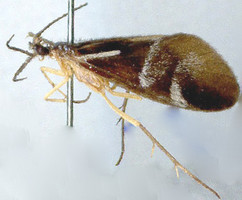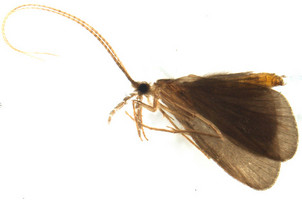Calamoceratidae
Ralph W. Holzenthal, Roger J. Blahnik, Aysha Prather, and Karl Kjer


This tree diagram shows the relationships between several groups of organisms.
The root of the current tree connects the organisms featured in this tree to their containing group and the rest of the Tree of Life. The basal branching point in the tree represents the ancestor of the other groups in the tree. This ancestor diversified over time into several descendent subgroups, which are represented as internal nodes and terminal taxa to the right.

You can click on the root to travel down the Tree of Life all the way to the root of all Life, and you can click on the names of descendent subgroups to travel up the Tree of Life all the way to individual species.
For more information on ToL tree formatting, please see Interpreting the Tree or Classification. To learn more about phylogenetic trees, please visit our Phylogenetic Biology pages.
close boxIntroduction
The family has long been recognized within the Trichoptera, being first established by Ulmer (1906). The nominotypical genus was included in a “section” of Leptoceridae by McLachlan and a few other early workers. The 8 genera are well defined and together comprise about 175 species from around the world. Anisocentropus McLachlan and Phylloicus Müller are the largest genera in the family with over 60 species each. The former is widespread in the Paleotropics of Africa, Asia, and Australia, with 1 outlying species in eastern North America. Phylloicus is endemic to the Neotropics, with several species extending their range into the southwestern USA. Banyallarga Navás is another Neotropical endemic of less than 20 species. The Neotropical fauna was recently revised in its entirety by Prather (2003, 2004). The other species rich genus in the family is Ganonema McLachlan, with about 20 species in the Oriental and eastern Palearctic regions. Smaller genera, with no more than 2 or 3 species each, include: Ascalaphomerus Walker (China), Calamoceras Brauer (Europe), Georgium Fischer (Japan, Thailand), and Heteroplectron McLachlan (eastern and western North America, Japan). Larvae of the family are well known for their flattened cases made of large pieces of excised leaves that completely camouflage the larva from above. Others build tubular cases of sand grains or hollow a twig to use as a case. The larvae inhabit the slower, depositional areas of small streams and rivers where they feed as shredders of leaf litter and other plant detritus. Larvae of a Brazilian species inhabit the “tanks” of water trapped by the leaf axils of bromeliads. Adults of many species have very brightly colored and patterned wings imparted by thickened hairs or scales. Many are more active during the day than most Trichoptera, as they engage in diurnal mating behavior. (From Holzenthal et al., 2007)References
Holzenthal R.W., Blahnik, R.J., Prather, A.L., and Kjer K.M. 2007a. Order Trichoptera Kirby 1813 (Insecta), Caddisflies. In: Zhang, Z.-Q., and Shear, W.A. (Eds). 2007 Linneaus Tercentenary: Progress in Invertebrate Taxonomy. Zootaxa. 1668:639–698.
Prather, A.L. (2003) Revision of the Neotropical caddisfly genus Phylloicus (Trichoptera: Calamoceratidae). Zootaxa, 275, 1–214.
Prather, A.L. (2004) Revision of the Neotropical caddisfly genus Banyallarga (Trichoptera: Calamoceratidae). Zootaxa, 435, 1–76.
Ulmer, G. (1906) Neuer beitrag zur kenntnis außereuropäischer Trichopteren. Notes from the Leyden Museum, 28, 1–116.
Title Illustrations

| Scientific Name | Phylloicus bicarinatus |
|---|---|
| Location | Madre de Dios, Peru |
| Specimen Condition | Dead Specimen |
| Life Cycle Stage | Adult |
| View | Lateral |
| Collection | UMSP |
| Type | Paratype |
| Source Collection | Barcode of Life Database (BOLD) |
| Scientific Name | Anisocentropus pyraloides |
|---|---|
| Specimen Condition | Dead Specimen |
| Life Cycle Stage | Adult |
| View | Lateral |
| Source Collection | Barcode of Life Database (BOLD) |
About This Page
Ralph W. Holzenthal

University of Minnesota, St. Paul, Minnesota, USA
Roger J. Blahnik

University of Minnesota, St. Paul, Minnesota, USA
Aysha Prather

Centre for Biodiversity and Conservation Biology, Royal Ontario Museum, Toronto, Ontario, Canada
Karl Kjer

Rutgers University, New Brunswick, New Jersey, USA
Correspondence regarding this page should be directed to Ralph W. Holzenthal at , Roger J. Blahnik at , Aysha Prather at , and Karl Kjer at
Page copyright © 2010 Ralph W. Holzenthal, Roger J. Blahnik, Aysha Prather, and Karl Kjer
 Page: Tree of Life
Calamoceratidae.
Authored by
Ralph W. Holzenthal, Roger J. Blahnik, Aysha Prather, and Karl Kjer.
The TEXT of this page is licensed under the
Creative Commons Attribution-NonCommercial-ShareAlike License - Version 3.0. Note that images and other media
featured on this page are each governed by their own license, and they may or may not be available
for reuse. Click on an image or a media link to access the media data window, which provides the
relevant licensing information. For the general terms and conditions of ToL material reuse and
redistribution, please see the Tree of Life Copyright
Policies.
Page: Tree of Life
Calamoceratidae.
Authored by
Ralph W. Holzenthal, Roger J. Blahnik, Aysha Prather, and Karl Kjer.
The TEXT of this page is licensed under the
Creative Commons Attribution-NonCommercial-ShareAlike License - Version 3.0. Note that images and other media
featured on this page are each governed by their own license, and they may or may not be available
for reuse. Click on an image or a media link to access the media data window, which provides the
relevant licensing information. For the general terms and conditions of ToL material reuse and
redistribution, please see the Tree of Life Copyright
Policies.
- First online 17 July 2010
- Content changed 20 July 2010
Citing this page:
Holzenthal, Ralph W., Roger J. Blahnik, Aysha Prather, and Karl Kjer. 2010. Calamoceratidae. Version 20 July 2010 (under construction). http://tolweb.org/Calamoceratidae/14595/2010.07.20 in The Tree of Life Web Project, http://tolweb.org/









 Go to quick links
Go to quick search
Go to navigation for this section of the ToL site
Go to detailed links for the ToL site
Go to quick links
Go to quick search
Go to navigation for this section of the ToL site
Go to detailed links for the ToL site